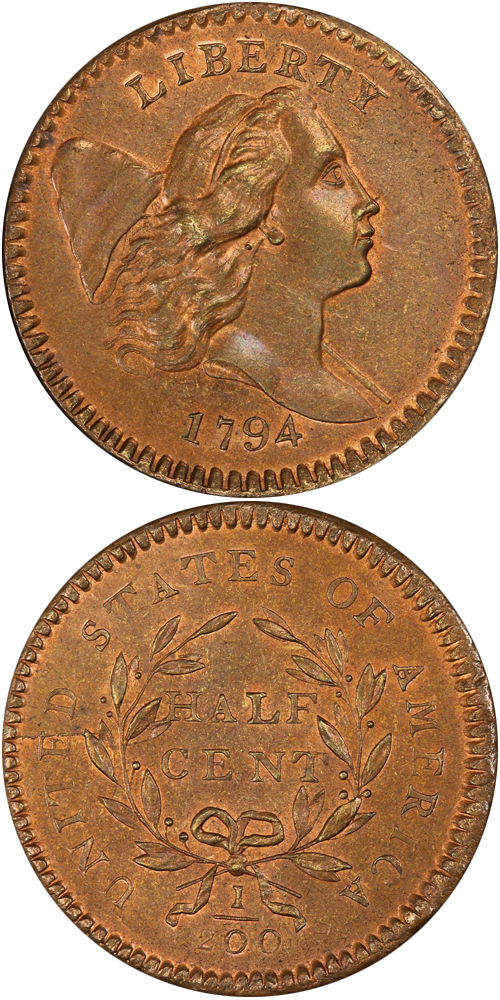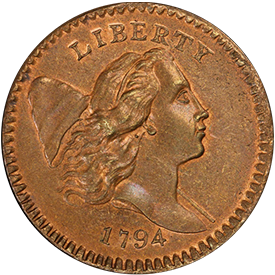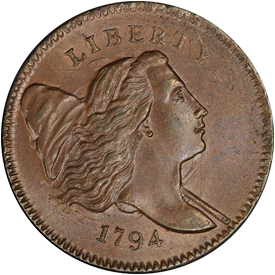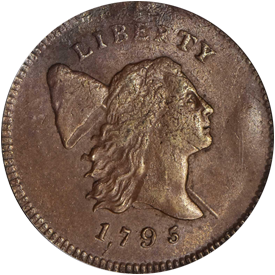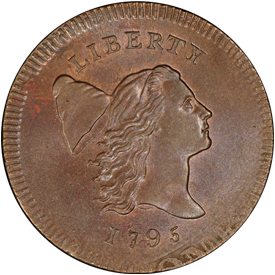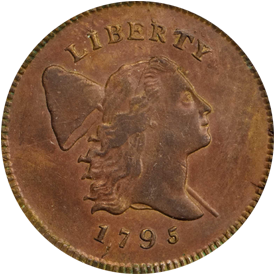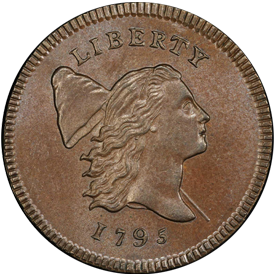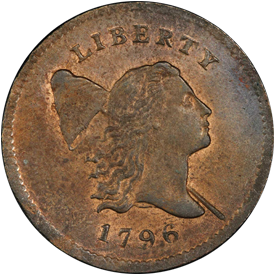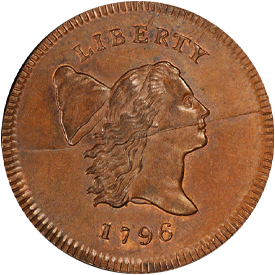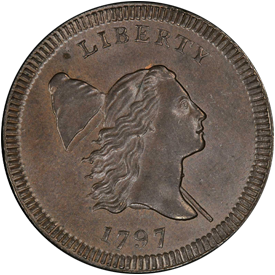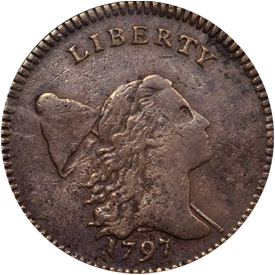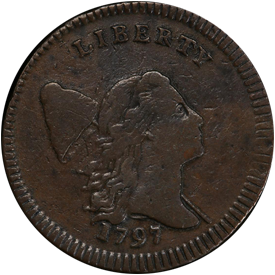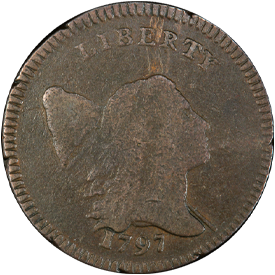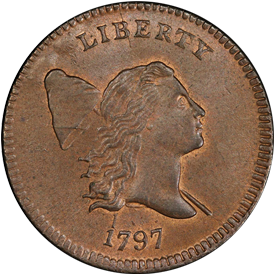Designed by: Robert Scot
Issue Dates: 1794-1797
Composition: Copper
Diameter: 23.5 mm
Weight: 6.73 grams (104 grains, thick planchet) 5.44 grams (84 grains, thin planchet)
Edge: Lettered TWO HUNDRED FOR A DOLLAR; some plain
Business Strike Mintage: 359,529
Proof Mintage: None
Half cents of the 1794-1797 years depict on the obverse Miss Liberty facing to the viewer's right, with LIBERTY above and the date below. Behind her flowing hair is a liberty cap on a pole. The edge is a series of denticles or indentations; the beaded border of 1793 had been discontinued. The reverse is similar in concept to 1793 except for the denticulated border. Although issues of 1794-1797 are commonly grouped together as a single type, in actuality half cents of 1794 have a larger head of Miss Liberty, while those of 1795 through 1797 have a delicate cameo-like head in a more open field area.
In general, pieces dated 1794 are rare in grades of Extremely Fine or better, while pieces dated 1795 can be acquired in Extremely Fine, About Uncirculated, or even Uncirculated grade, although an Uncirculated specimen may require several years of searching. The half cents of 1794 are apt to have rough surfaces, often with dark color or granularity. On the other hand, smooth, light brown surfaces are characteristic of 1795 through 1797. All 1794 cents have lettered edges, as do certain 1795 issues and a few minted in 1797. The rest have plain edges.
A popular condition objective for this style is Fine to Very Fine. Such pieces are sharp enough to show the details, yet they are priced much less than higher grades. Good or Very Good pieces, if carefully selected, can be quite attractive and desirable.
Further Reading
Half cents of 1794 represent a distinct type. As such, they should be differentiated in a type set, but tradition dictates otherwise. Half cents of 1794 are usually grouped into the so-called Head Facing Right Liberty Cap design of 1794-1797.
The 1794 issues possess many characteristics which differ from the later pieces of 1795-1797. Generally, half cents of 1794 are on heavier planchets and are in higher relief with the portrait of Miss Liberty occupying a much larger proportional space on the obverse. Most 1794 half cents occur with a deep brown or black color. 1795 half cents are usually light brown.
Whereas large cents have been studied to a fare-thee-well, half cents have been relatively neglected by numismatists over the years. Indeed, Roger Cohen referred to this denomination as "little half sisters, unwanted and considered to be of little importance." He was referring to the original status of half cents, but the sentiment can be extended to the modem collecting fraternity as well.
During the years in which half cents were coined, large cents were the staple commodity. Half cents were struck only at occasional intervals and in far lesser amounts. Little official attention appears to have been paid to them. The same is somewhat true today. Whereas early large cents are avidly collected by die varieties and furnish the main focus of the Early American Coppers Club, half cents are collected in the shadows. Perhaps part of the reason for the popularity of large cents lies in the excellence of Penny Whimsy, the main reference book used by large cent collectors. This book, which is virtually a philosophy or discipline, is much more than a listing of die varieties. The author, Dr. William H. Sheldon, penned words that are captivating and informative. One cannot read the Penny Whimsy book without "catching the fever." By contrast, the two classic half cent references, United States Half Cents, by Ebenezer Gilbert and American Half Cents-the "Little Half Sisters," by Roger S. Cohen, both concentrate on die variety characteristics, and offer little in the way of background information, collecting methodology, or half cent philosophy. The new Breen book, however, may in time draw attention to the half cent denomination.
Perhaps the most important reason for the half cent's limited popularity may be that the series is dotted with what some people have called "impossible" rarities-pieces that are unlikely to be offered to the average numismatist. Pieces such as the 1796 half cents in general, and the 1796 half cents without pole in particular, and the Proof rarities of 1831, 1836, and 1840 through 1848, plus the 1852, are examples.
Still another reason for the apparent half cent collector apathy may be that the series is discontinuous. A date sequence of half cents has many gaps, whereas a sequence of large cents extends from the years 1793 through 1857, with the solitary exception of the year 1815.
Half cents from 1794 to 1797 feature Miss Liberty, with a liberty cap behind her head, facing to the right, the opposite direction from the 1793 year. As noted, heads on the 1794 half cent varieties are substantially larger than those of 1795-1797. Nine different die varieties are known, some of which are scarce. Nearly all half cents of the 1794 year were struck on dark, rough copper planchets. Most specimens seen today are in worn grades, with Good to Fine representing the range of the main population. Very Fine pieces are elusive, those grading Extremely Fine are very scarce, and a piece in a higher grade is a rarity.
Half cents of 1795 feature a much smaller head with less detail on the higher points. The motif presents a cameo-like appearance, for it is a small portrait set in the middle of a large field. Half cents of 1795 were, for the most part, poorly struck. Even pieces in higher grades are apt to be very weak in certain areas. The same is true of many large cents of this particular year.
Two famous varieties of 1795 half cents can be found. The first is the so-called Punctuated Date, which is characterized by the date written as 1,795. This does not represent an intentional comma after the first digit but, rather, is a stray mark put on the die by an engraving tool. The second variety is the famous 1795 half cent without a pole to the liberty cap. This variety was also not produced intentionally. Rather, a worn die of the regular with-pole variety was ground down to make the surface of the die suitable for further use. During the grinding process some of the features in the die in lower relief were removed, including the cap pole. The date was weakened in the process, with the result that many 1795 half cents of this variety have the date showing very lightly or not at all. Every once in a while, one of these appears on the market with the hope that it is a specimen of the rare 1796 without-pole variety, but the 1795 and 1796 pieces can be differentiated by other means, the quickest of which is that the 1796 half cent variety without pole always occurs with a prominent horizontal die break on the obverse. Also, the date on 1796 pieces is very bold, and specimens are not apt to be seen without this feature.
Early 1795 half cents were struck on thick planchets with lettered edges, somewhat similar to the style of 1793 and 1794. Later in the year the form was changed to a thin planchet with plain edge. Many interesting variations occur among half cents of this year. I once owned an example struck on a planchet made from a trial piece for a copper 1794 half dollar. Apparently in the year 1794 a number of trial strikings in copper were made (probably to test the dies) of 1794 half dollars. Rather than waste these 1794 half dollars it was decided to cut half cent planchets from the centers of them. Today several such pieces are known and are mentioned in Dr. J. Hewitt Judd's book, United States Patterns and Trial Pieces.
More often seen are 1795 half cents (and some of 1797 as well) struck on planchets cut from Talbot, Allum & Lee tokens. In 1794 and 1795 Talbot, Allum & Lee, importers with facilities located at 241 Pearl Street, New York City, obtained from England a large number of tokens bearing on the obverse a standing goddess and on the reverse a fully rigged sailing ship. During one of the periodic copper shortages at the Mint the government purchased 1,076 pounds of Talbot, Allum & Lee tokens, from which apparently somewhere between 32,000 and 50,000 half cents were struck, most dated 1795, with a few dated 1797. Today, 1795 and 1797 half cents are occasionally seen with traces of the Talbot, Allum & Lee design. Sometimes these traces are quite spectacular and show part of the original lettering, the ship's rigging, and other features.
1795 half cents usually are seen with light brown surfaces free of striations. Because striking was irregular, weakness of certain portions of the lettering, date, or other features is the rule, not the exception. Most examples observed are in lower grades, from About Good through Fine, but a number of higher-grade coins exist as well. Although I have owned several Uncirculated pieces with chocolate brown surfaces, these are rare.
Half cents of 1796 occur in two varieties: with pole to cap and without. Unlike the 1795 half cent without pole (which was caused by regrinding a die that originally had a pole), the omission on the 1796 apparently was a die blunder. The engraver simply forgot to include it! The 1796 without pole half cents that I have seen or owned have all had a prominent horizontal die break bisecting the obverse. Like 1794 half cents, genuine issues of the year 1796 tend to have darker surfaces – deep brown or even black. Also, porosity and surface irregularities are characteristic.
Probably no more than 15 or 20 examples are known of this issue, a population that projects the 1796 half cent without pole into the forefront of American numismatic rarities. Nearly all of these are in worn condition, but three in Uncirculated grade have been reported.
The most often seen (and this really isn't very often!) variety of the 1796 is that with pole to cap. Several dozen examples are known of this issue, a number sufficient that any collector desiring to own one can do so with a reasonable amount of patience. Most known examples are well worn, including one coin with corroded surfaces that came to light when excavations were made during the restoration of portions of Independence Hall in Philadelphia.
In the nineteenth century one Dr. Edwards sold a struck copy of the 1796 half cent with pole, made by Singleton, a British coiner. Singleton's intention was not to make a counterfeit coin for circulation but, rather, to provide a "space filler" for numismatists who could not find or could not afford an authentic example. This piece differs from the original 1796 half cent in the style of the head and the larger size of the letters.
One of the surprises I encountered during the early 1950s when I was beginning my numismatic interest was the result of ordering a half cent that was described something like, "1796 half cent, Extremely Fine, $300," from A.J. Fink, a Dayton, Ohio dealer. Believing that the piece should be worth at least $1,000 at the time, but hoping for the best anyway, I mailed my order. By return mail came a 1796 Edwards copy. I was but an amateur at the time, but I did possess a copy of Richard Kenney's monograph, Struck Copies of Early American Coins, and I instantly recognized the "1796 half cent" for what it was – a forgery.
I sent the piece back to the dealer with a fairly long and helpful (so I thought) explanation of what the piece really was, believing that Mr. Fink somehow was not familiar with either the Edwards copy or Kenney's monograph. Back came a rather tart reply: "You did not expect an original piece for $300, did you?"
Around 1968 I acquired another 1796 Edwards half cent as part of a collection. I took a pair of tinsnips and cut the coin into four pieces – and then threw it away so that it would not fall into the hands of a future collector and cause deception. My reason for destroying this piece, a coin that might have some numismatic interest on its own, was more than justified by the fact that the collector from whom I purchased it had acquired it as a genuine piece many years earlier. It was with a touch of mixed feelings that I listened to a half cent specialist at a convention a decade later. "Have you ever seen an Edwards copy?" he asked. I told him the story of the two which I had seen or owned. "I would pay $2,000 for one," he then informed me! Actually, while the Edwards copy possesses numismatic merit on its own – it has a story to tell – it undoubtedly would be subject to seizure by government authorities under federal counterfeiting laws, so anyone buying one would encounter a risk of confiscation, not to mention illegality.
The last year of the 1794-1797 design, 1797, encompasses characteristics of its own. Pieces of this date are generally sharper, as far as definition of details is concerned, than are issues of 1795. Often they are seen struck on large planchets, a feature that gives the milling or denticles on the obverse an unusual prominence. These bold toothlike projections tend to frame the central portrait and give the issues a special appeal. Some half cents of 1797 are known struck on planchets made from cut-down Talbot, Allum & Lee cents. These typically show traces of lettering and ship's rigging and lend a dimension of interest.
Most 1797 half cents are of the plain edge variety. However, a few were struck on planchets with lettered edges. Unlike lettered-edge half cents of early 1795 and earlier times, which were struck on thicker and heavier disks, the plain-edge 1797 issues are struck on thin, light planchets. Specimens of the lettered edge 1797 half cent are scarce in all grades and are exceedingly rare in any preservation above Fine. In fact, I do not recall ever having seen one better than Very Fine.
A curious variety among 1797 half cents is the Low Head issue, which features the portrait of Miss Liberty far too low on the coin, crowding the date against the border. All lettered edge 1797 half cents are struck from the Low Head die, but many plain-edge half cents were struck from these dies as well.
The best-known 1797 half cent variety is the 1 above 1 issue. The engraver first started the date very high in the field and near Miss Liberty's hair. This error was realized as soon as the first digit was in the die. Subsequently the date was correctly cut in the proper place, but the erroneous 1 was not effaced from the die, so on specimens seen today it is sharp and clearly visible.
Half cents of 1797 are often seen on deep brown or even black planchets, reflective of the quality of the copper used to make them. With relatively few exceptions, most are in well-worn grades. Somewhere in my memory is the sight, around 1954, of a mint red Uncirculated 1797 half cent, the obverse of which was struck from a shattered die. Where it is now, I don't know.
No half cents bearing the dates 1798 or 1799 were struck, thus creating the first of many gaps in the emission sequence of this denomination.
